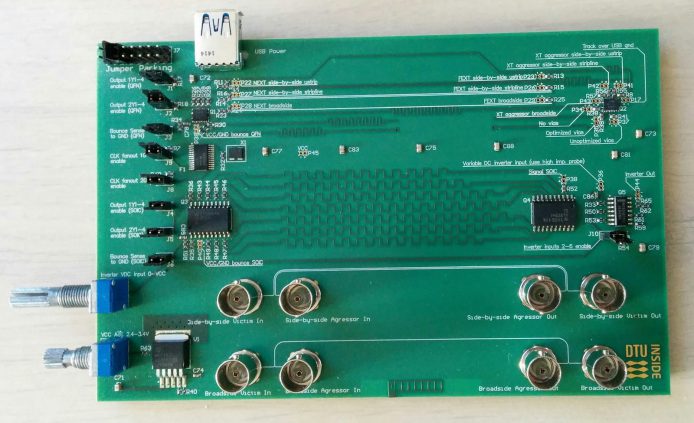Both S-parameters and crosstalk are key signal-integrity subjects – this is how we combine the two. In the signal integrity classes, we run at the Danish Technical University (DTU), the students get to do actual measurements in the lab and compare that to actual simulations. Having 3 full weeks to go through the subjects really opens up the possibilities for what you can do. And we think it is important that the students leave DTU with a good understanding of signal integrity at a practical level.
Simulation
One of the major subjects in SI is crosstalk – maybe not a big surprise. This can be easily simulated in Hyperlynx from Mentor Graphics and SigXplorer from Cadence:
Cadence SigXplorer simulation setup for crosstalk.
 Hyperlynx simulation setup for crosstalk.
Hyperlynx simulation setup for crosstalk.
Measurement in time-domain
And crosstalk can be easily measured on the lab exercise PCB using an oscilloscope. We have a simple driver run from an oscillator driving one trace across the board. The other trace runs next to it with test points in both ends (more on those in another post). By attaching the oscilloscope to the test points, both near-end and far-end crosstalk can be measured on an oscilloscope. A standard time-domain measurement. This is the lab exercise board we use at DTU:
Measurement as S-parameters
If you look carefully, you can see how the test features for crosstalk are repeated with BNC connectors (remember this is university… and Denmark… so they can not afford SMA connectors etc. :-/).
The purpose here is to give the students an opportunity to measure crosstalk with a network analyzer as S-parameters as well. This is a very useful way of looking at a lot of signal integrity issues. If you want to do similar measurements (to higher frequencies), there is a test board ready for use from CCN Labs called the SKIT1 board:

When looking at crosstalk as S-Parameters, near-end and far-end crosstalk become S31 and S41 respectively (with the recommended port numbering scheme). For near-end crosstalk simulations may look like this:
The students get to learn how they convert forth and back between the time-domain and frequency domain, but the most important thing is really how you can use the two different views of the same measurement to learn important aspects of the interconnect.
In the last couple of years, Eric have been busy setting up a “Signal Integrity Academy” online for LeCroy, so he didn’t have to travel so much. This is, in essence, all the lectures in easily digestible video bites. Eric’s live classes are still in high demand worldwide, but he gives only a few per year. Luckily for us Nordic people, Eric’s wife is Swedish. So… we had the pleasure of having him in the Nordic region twice in 2015. PLEASE do yourself the favor and go to his class – you will learn so much and meet a truly excellent and world-class instructor that goes beyond expectations. PLUS you get access to all the 90 hours of video, so you can go back and re-watch any part of the class afterward – and discuss it with your peers if you need it.Eric Bogatin
 Often called the master of S-Parameters. Mostly because he has been teaching S-Parameter classes worldwide for many many years. But also because he is really good at explaining how you can use the frequency-domain view of things to your advantage. There is a lot of information which is really easy to access with just some basic knowledge, once you get used to working with S-Parameters.
Often called the master of S-Parameters. Mostly because he has been teaching S-Parameter classes worldwide for many many years. But also because he is really good at explaining how you can use the frequency-domain view of things to your advantage. There is a lot of information which is really easy to access with just some basic knowledge, once you get used to working with S-Parameters.




 M.Sc.EE, SI Consultant
M.Sc.EE, SI Consultant